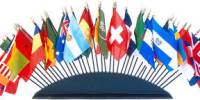A trade bloc is an agreement between countries intended to reduce or remove barriers to trade within member countries. It is a type of intergovernmental agreement, often part of a regional intergovernmental organization, where barriers to trade (tariffs and others) are reduced or eliminated among the participating states. A regional trading bloc is a group of countries within a geographical region that protect themselves from imports from non-members. It is a type of intergovernmental agreement, often part of a regional intergovernmental organization, where regional barriers to international trade, are reduced or eliminated among the participating states, allowing them to trade with each other as easily as possible.
Trading blocs are a form of economic integration, and increasingly shape the pattern of world trade. There are several types of trading bloc:
- Free Trade Area – Members agree to reduce or abolish trade barriers such as tariffs and quotas between themselves. For example, the North American Free Trade Agreement (NAFTA) between the USA, Canada & Mexico created a free trade area.
- Customs Union – Countries that belong to customs unions agree to reduce or abolish trade barriers between themselves and agree to establish common tariffs and quotas with respect to outsiders.
- Common Market – This is a customs union in which the members also agree to reduce restrictions on the movement of factors of production – such as people and finance – as well as reducing barriers to the sale of goods. For example, no permits are required to work in another member country.
- Economic Union – A common market that is taken further by agreeing to establish common economic policies on such things as taxation and interest rates and, even, a common currency. For example, the European Union is an economic union.
So, a trading bloc is a formal agreement between two or more regional countries that remove trade barriers between the countries in the agreement while keeping trade barriers for other countries. Trade blocs can be stand-alone agreements between several states (such as the North American Free Trade Agreement) or part of a regional organization (such as the European Union). Depending on the level of economic integration, trade blocs can be classified as preferential trading areas, free-trade areas, customs unions, common markets, or economic and monetary unions.
The most significant trading blocs currently are:
- European Union (EU) – a customs union, a single market and now with a single currency
- European Free Trade Area (EFTA)
- North American Free Trade Agreement (NAFTA) between the USA, Canada, and Mexico
- Mercosur – a customs union between Brazil, Argentina, Uruguay, Paraguay, and Venezuela
- Association of Southeast Asian Nations (ASEAN) Free Trade Area (AFTA)
- Common Market of Eastern and Southern Africa (COMESA)
- South Asian Free Trade Area (SAFTA) created in 2006 with countries such as India and Pakistan
















